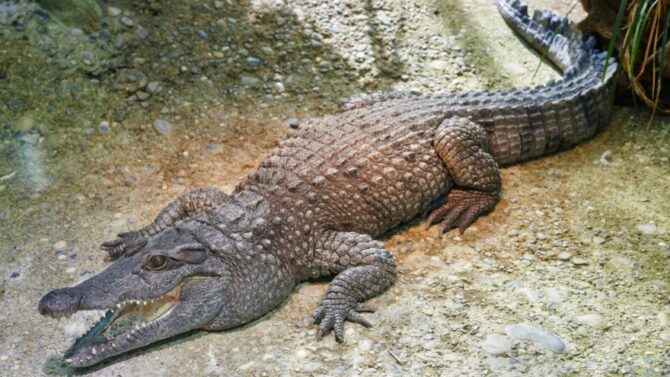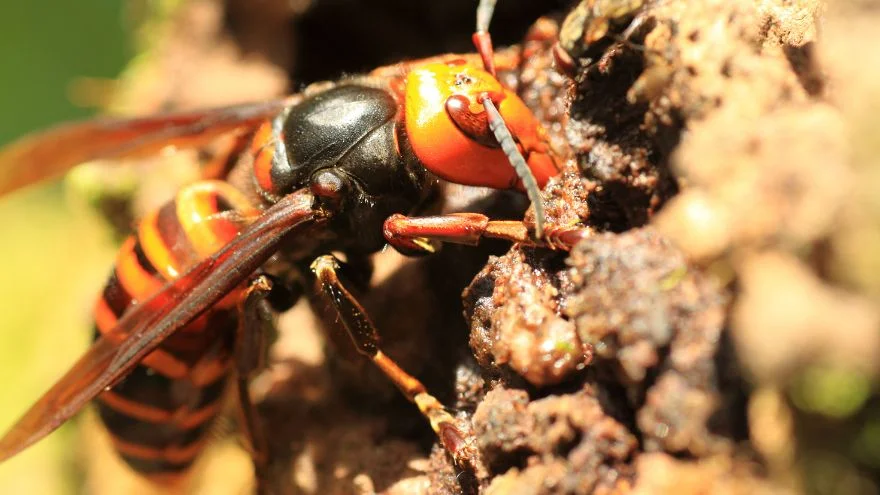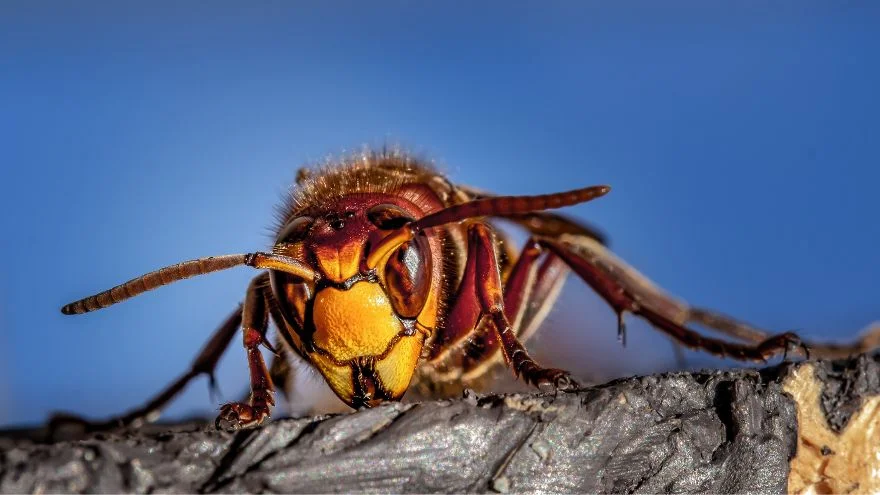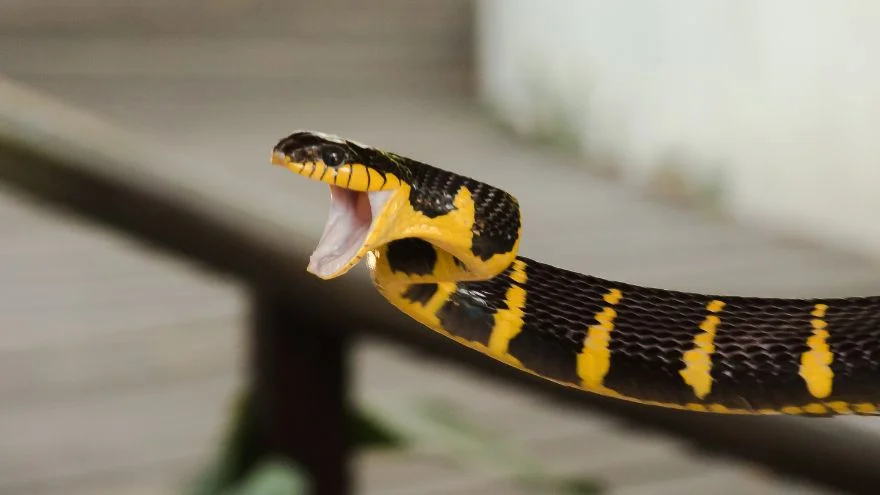Asia is the world’s largest continent by area and is the world’s most populous in terms of human and wildlife populations.
The continent has the world’s highest point, Mount Everest, Nepal, and the world’s lowest point, Challenger Deep, in the Mariana Islands, suggesting a diverse array of habitats, weather, and topography that support wildlife.
Asia’s mountain systems, forests, plateaus, deserts, freshwater, and saltwater environments are home to several animals, including the tiger, the continent’s biggest carnivorous mammal, the king cobra, the world’s longest venomous snake, the komodo dragon, the largest extant lizard, and many more.
Without further ado, let us discuss extensively wildlife in Asia — animals in the world’s largest continent you should know.
Wildlife in Asia: Top Native Animals in Asia
Tigers, elephants, lions, pandas, and bears are among the few animals children identify when they start learning about wildlife.
Adults, too, might have heard several stories or read facts about these animals and would jump at any chance to observe them in their natural habitat or captivity.
A trip to Asia presents one with the opportunity to see one or more of these animals. Here we present Asia’s top wildlife.
Tiger
Scientific Name: Panthera tigris
The tiger, the world’s largest extant cat, is an endangered species (between 3,062 and 3,948 in the wild); however, it has a decent population in Asia.
This large cat has six subspecies on the continent, the Amur, Indochinese, Sumatran, South China, Indian, and Malayan tigers.
Tigers inhabit mangrove swamps, grasslands, tropical rainforests, savannahs, and rocky areas in North Korea, India, China, and Indonesia.
Like other wild cats, tigers are apex predators, with deer and wild boars making their favorite diets.
There is no surprise that the tiger is among the world’s most recognizable megafauna, but its cultural significance is much more, featuring prominently in many cultures’ ancient mythology and folklore.
India, South Korea, Malaysia, and Bangladesh have the tiger as their national animal.
Asian Elephant
Scientific Name: Elephas maximus
Elephants exist in Africa under a different genus, Loxodonta, but the Asian Elephant is a species under the genus Elephas. Asian elephants differ from their African counterparts primarily in size.
The Asian Elephant has smaller ears, level or convex backs, feet with more nail-like structures, and two hemispherical bulges on its forehead.
One can find Asian elephants in India and Southeast Asia, living in grasslands, forests, and scrublands due to the megaherbivorous feeding that imposes them to consume up to 300 pounds of plant matter daily.
The Asian Elephant is Asia’s largest extant land animal; sadly, it is classified as “Endangered” by the IUCN, with an estimated 48,323 to 51,680 elephants remaining in the wild in 2019.1 2
Asian Black Bear
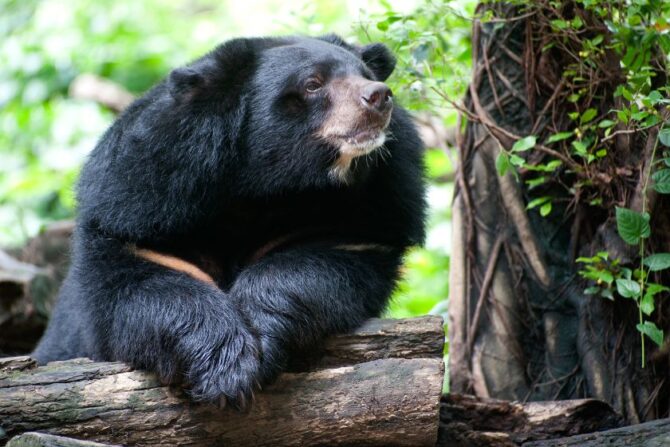
Scientific Name: Ursus thibetanus
The black bear is North America’s most common bear species, and the Asian black bear is among Asia’s top wildlife.
However, geographical specifications, locomotive adaptation, and a slight difference in appearance differentiate both species.
The Asian black bear has a white patch on its chest, from which it gets the name “white-chested bear.” Moreover, it is primarily adapted to an arboreal lifestyle.
Asian black bears inhabit the Himalayas, southeastern Iran, the northern Indian subcontinent, the Korean Peninsula, China, Japan, and Taiwan, favoring mixed, deciduous, and thornbush forests.
Asiatic Lion
Scientific Name: Panthera leo leo
Almost every lion in the wild occupies sub-Saharan Africa’s scrublands, savannahs, and grasslands, but a small population of Asiatic lions inhabits the Gir Forest in India.
The Asiatic and African lions are subspecies of the same species differentiated by the male Asiatic lion’s shorter, sparse, and darker mane than the African lion’s fuller mane.
Researchers believe the Asian lion lived through much of the Middle East to northern India; sadly, the lion survives in the wild only in India as a single subpopulation.
Giant Panda
Scientific Name: Ailuropoda melanoleuca
Zebras are not the only mammals characterized by black and white coats; the panda bear, endemic to China, is among the most easily identified animals.
The giant panda is a herbivore, with bamboo leaves and shoots making up its primary diet in the wild, while wild tubers, grasses, and meat from birds, carrion, and rodents make up occasional diets.
Therefore, pandas occupy the temperate forests high in southwest China’s mountains.
In popular culture, the giant panda often serves as China’s national symbol and a capitalist lease model based on financial transactions.3
Endemic Asian Animals
Some species exist everywhere, while others are ecologically distributed in specific locations.
Several animal species live in Asia, but the following are endemic to the continent.
Sun Bear
Scientific Name: Helarctos malayanus
Conservation Status: Vulnerable
The sun bear, the smallest bear, is native to Southeast Asia’s deciduous and evergreen forests.
The forests support the sun bear’s arboreal lifestyle, as the most arboreal of all bears, thanks to the forests’ high dominance of trees and shrubs.
The sun bear has adaptations for climbing, with a flattened chest, inward-turned front feet, and powerful forelimbs with large claws; however, their most notable identity is the orange to cream-colored chest patch that looks like a rising sun.
India, Vietnam, Bangladesh, Laos, Myanmar, Indonesia, Cambodia, Malaysia, China, and Thailand are possible locations to find a sun bear.
Clouded Leopard
Scientific Name: Neofelis nebulosa
Conservation Status: Vulnerable
The clouded leopard is named for its cloud-like spots; however, it is a separate genus of cats and not a type of leopard. While the leopard is from the genus Panthera, the clouded leopard is from the genus Neofelis.
Leopards have pale yellowish to dark golden coat colors with dark spots grouped in rosettes, while clouded leopards have dark grey to ground coat colors, largely with black and dark dusky-grey blotched patterns.
While both species are not of the same genus, the clouded leopard is a wild cat endemic to Asia. The Himalayas’ foothills, Southeast Asia, and South China are home to the clouded leopard.
This cat inhabits lowland tropical rainforests, dry woodlands, secondary forests, and mangrove swamps and can even survive in areas reaching 9,000 feet above sea level.
Draco Lizards
Scientific Name: Draco
Draco lizards are a group of lizards endemic to Asia. Some people identify them as flying lizards, gliding lizards, or flying dragons, thanks to their ability to glide through the air for as long as 200 feet.
About forty species of these lizards inhabit Southeast Asia’s tropical rainforests, living on trees and feeding on insects.
One of the species, the Indian flying lizard (Draco dussumieri), is native to India and the only Draco lizard species distributed in southern India.4
Red Panda
Scientific Name: Ailurus fulgens
Conservation status: Endangered
The red panda bears a resemblance to the panda bear but differs in coat color with a red or orange-brown coat, black belly and legs, and white markings on its face.
It is endemic to southwestern China and the eastern Himalayas. Like the panda bear, red pandas are herbivores and feed primarily on bamboo shoots and leaves; they have an arboreal lifestyle, with flexible joints and curved semi-retractile claws as body modifications that support climbing.
China, Nepal, India, Myanmar, and Bhutan are notable locations to find the red panda.
Sloth Bear
Scientific Name: Melursus ursinus
Conservation status: Vulnerable
The sloth bear is medium-sized species under the genus Melursus, the only species under its genus. While the black, grizzly, and polar bears are under the Ursus genus, Asian bears are classified differently.
Sloth bears feed on insects, with body modifications, including a long lower lip and palate used to support their feeding.
Sloth bears are characterized by their long, ragged fur, extended, sickle-shaped claws, and mane around the face.
They are thinner than the Asian black bear and the sun bear, other bear species endemic to Asia.
The sloth bear remarkably occupies a wide range of habitats, from moist and dry tropical forests, savannahs, and scrublands, to grasslands.
Mouse-like Hamsters
Scientific Name: Calomyscus
Like Draco lizards, mouse-like hamsters are a group of species endemic to Asia. Their name is a misnomer as they were grouped as hamsters.
However, their lack of flank glands, short tails, and cheek pouches classify them as mouse-like rodents.
Mouse-like hamsters are small rodents occupying semi-mountainous areas and rocky outcrops in desert regions like Afghanistan, Syria, Turkmenistan, Azerbaijan, Iran, and Pakistan.
Indian Rhinoceros
Scientific Name: Rhinoceros unicornis
The Indian rhino is a rhinoceros species endemic to the Indian subcontinent. It is priced as one of the continent’s originals, inhabiting grasslands and wetlands in India, Nepal, Bhutan, and Indonesia.
They differ from other rhinoceros species, with a segmented hide resembling a formidable coat of natural body armor and the possession of one horn, a body feature they share with the Javan rhino. In contrast, other rhino species have two horns.
The Most Dangerous Asian Animals
Asia’s wildlife is appeasing, but some animals on the continent are notorious for being aggressive, irritable, or territorial. Most animals have a defense mechanism, and they put them to good use if they feel threatened.
The tiger, Asiatic Lion, and Asian black bear rank among the continent’s most dangerous animals.
Still, there are other deadly animals you do not want to encounter. Here are some of the most dangerous animals in Asia.
Komodo Dragons
Scientific Name: Varanus komodoensis
The Komodo dragon, the world’s largest, heaviest lizard, is one of Asia’s most dangerous. The lizard is a dominant stealth hunter with a powerful and venomous bite.
It is endemic to Asia, inhabiting a few Indonesian islands, including Komodo, Gili Motang, Rinca, and Flores, where it scavenges for carcasses or hunts animals from rodents to water buffalos.
Komodo dragons have shark-like teeth and venom that cause hemorrhaging and a sudden drop in blood pressure that sends them into shock.5
The dragon attacked twenty-four people, killing five in thirty-eight years between 1974 and 2012 on Komodo Island.6
Saltwater Crocodile
Scientific Name: Crocodylus porosus
Crocodiles have a fearsome reputation for attacking humans, and the saltwater crocodile is no exception.
The saltwater crocodile inhabits saltwater habitats and brackish wetlands on India’s east coast across Southeast Asia, the Sundaic region, northern Australia, and Micronesia.
While it is priced for being one of Asia’s top wildlife, no Asian wants to encounter the reptile in the wild. The saltwater crocodile generates about 3,700 pounds per square inch (psi) per bite, the most of any crocodile species.
Reports of saltwater crocodiles attacking humans in Australia are more prominent than in Asia but do little to undermine the crocodile’s potential dangers.7
Bull Shark

Scientific Name: Carcharhinus leucas
The Great White Shark and Tiger Shark are ferocious marine beasts in Asian waters, but the bull shark is more fearsome, being notorious as one of the continent’s most dangerous animals.
The bull shark is infamously revered as the most dangerous shark to humans because of its aggressiveness, adaptiveness, preference for shallow coastal waters, and migration ability.
The shark can survive in shallow brackish and freshwater systems, increasing their chances of humans encountering them.
The bull shark, as expected, records double digits of human attacks; one that readily comes to mind is a 2020 encounter between a bull shark and a 75-year-old European tourist, resulting in severe injuries for the tourist in Thailand.
Similar incidents occurred in the Southeast Asian country this century, confirming the bull shark as one of Asia’s deadliest animals.
Fattail Scorpions
Scientific Name: Androctonus
Fattail scorpions are some scorpion species characterized by their fat tails. While these scorpions are under four inches long, they have neurotoxic venoms that make them one of the world’s deadliest groups of scorpion species.
These scorpion species abundantly exist in West and North Africa but have considerable populations in Asia.
One can find fattail scorpions in India, Afghanistan, Pakistan, Iram, Iraq, Yemen, Qatar, and Kuwait, among other Asian countries.
King Cobra

Scientific Name: Ophiophagus hannah
The monocled cobra, cape cobra, and other cobra species are among the world’s deadliest snakes; therefore, the king cobra, the world’s longest venomous snake and king of majestic threat displays, is no exception.
The king cobra may grow over thirteen feet long but has a more fearsome identity than its length. King cobras are deadly, injecting large quantities of venom in some bites.
Fortunately, this snake avoids human confrontation as much as it can but will waste no time striking a target from a long range and even above the ground if it feels cornered or threatened.
The king cobra primarily inhabits South and Southeast Asia, including India, Nepal, Bhutan, Myanmar, Bangladesh, Thailand, Cambodia, and Southern China.
The King cobra holds a prestigious status in India, representing other crawling animals as the country’s national reptile.
Endangered Asian Animals
Asia provides shelter and favorable conditions for many species; sadly, some suffer from overhunting, climate change, and habitat destruction that may force them into extinction in the next few decades.
Here are some of the continent’s endangered animals.
Sumatran Orangutan
Scientific Name: Pongo abelii
Conservation status: Critically Endangered
All three orangutan species inhabit Malaysia and Indonesia’s rainforests. However, the Sumatran orangutan exists only in northern Sumatra Island, Indonesia.
Like other orangutan species, the Sumatran orangutan has reddish hair that appears bright orange in its young and darkens to maroon or chocolate as they age.
However, Sumatran orangutans have thinner and longer faces and long hair with a paler red color that differentiates them from the other species.
Sadly, this ape is a critically endangered species, with an estimated 7,000 left in the wild in 2015.
Sunda Pangolin
Scientific Name: Manis javanica
Conservation status: Critically Endangered
The Sunda pangolin is one of four pangolin species inhabiting Asia. The reptile-looking mammal can measure up to three feet, eleven inches from head to tail tip.
Sunda pangolins live in primary, secondary, and scrub forests or cultivated areas like gardens, oil palms, and rubber plantations and feed on insects, with a long, sticky tongue well-adapted for this purpose.
While one may find this pangolin throughout Southeast Asia, including Thailand, Cambodia, Malaysia, Singapore, Vietnam, and Indonesia, it is a critically endangered species, primarily due to poaching.
Wild Bactrian Camel
Scientific Name: Camelus ferus
Conservation status: Critically Endangered
The wild Bactrian camel is a large, double-humped camel endemic to the steppes of central Asia.
These camels inhabit arid areas with scarce water sources and very little vegetation, despite shrubs being their primary food source. However, they can travel long distances to mountains where they can find springs.
Northwest China and Southwest Mongolia have wild Bactrian camels in the wild, the only areas in Asia and the world where this camel exists in the realms of undomesticated nature.
With only about 1,000 wild Bactrian camels living in the wild, they are flagged “Critically Endangered” by the IUCN.8
White-bellied Heron
Scientific name: Ardea insignis
Conservation status: Critically Endangered
The white-bellied heron is a beautiful bird prominently identified by a whitish belly, with uniform dark grey plumage and long silvery or whitish feathers on the rear crown and lower foreneck.
We would like to see this graceful bird in its natural habitat, northeast India, Myanmar, and the foothills of the eastern Himalayas’ wetlands of tropical and subtropical forests.
However, less than 300 mature white-bellied herons remain in the wild, narrowing the chances of seeing such a wish come true.
The white-bellied heron is a critically endangered species, and habitat loss and human disturbance continue to threaten the second-largest heron’s existence.
Saiga
Scientific Name: Saiga tatarica
Conservation status: Critically Endangered
The saiga is an antelope endemic to the Eurasian ecoregion, favoring the areas in Mongolia, Uzbekistan, and Kazakhstan.
The saiga differs from other envelopes prominently by appearance, with closely spaced, bloated nostrils directed downward and thick, slightly translucent, wax-colored horns with twelve to twenty pronounced rings.
Sadly, Asia is on the brink of losing its Ice Age antelope, habitat loss, poaching, mass epizootic mortality, and climate fluctuations, such that the species is flagged “Critically Endangered” by the IUCN.
Eastern Black-Crested Gibbon
Scientific Name: Nomascus nasutus
Conservation status: Critically Endangered
The eastern black-crested gibbon is one of the eighteen gibbon species; it is characterized by the black fur on its crown, from which it got its name.
The small-framed ape has suffered an 80% population decline in the past forty-five years, earning an unfortunate status as a critically endangered species.
“Half bread is better than none,” they say; scientists believed the eastern black-crested gibbon was extinct until 2002 when they discovered a small population in Vietnam and later in China, the two countries where the ape exists in the wild.9
While conservation efforts have seen a slight increase in the number of eastern black-crested gibbons since their discovery, the ape’s population is far from mind-settling.
Snakes in Asia
Asia has no shortage of snakes in the wild, with over 150 venomous species. Let’s consider members of Asia’s snake kingdom.
Saw-Scaled Vipers
Scientific Name: Echis carinatus
Saw-scaled vipers are a species of twelve highly venomous species in Asia. While these snakes are relatively small, usually below two feet, they are notorious for a distinctive threat display that involves rubbing their body together to produce a sizzling sound.
Saw-scaled vipers live in India, Pakistan, Sri Lanka, and parts of the Middle East’s arid regions and dry savannas, where they feed on insects, worms, amphibians, reptiles, and small mammals.
Saw-scaled vipers are irritable and very aggressive, repeatedly envenomating their victims with their hollow fangs.
Their venom is haemotoxic and cytotoxic, deterring blood clotting and causing significant cell and tissue damage.
Russell’s Viper
Scientific Name: Daboia russelii
The Russell’s viper ranks amongst Asia’s deadliest snakes, earning its status as one of India’s most venomous snakes.
Russell’s vipers are abundant in India but occupy the entire Indian subcontinent, including Bhutan, Bangladesh, Nepal, Maldives, Sri Lanka, and Pakistan.
They inhabit open or bushy areas, scrub jungles, forested plantations, and farmlands, where they primarily eat rodents; however, insects, small reptiles, and crabs also make the menu.
Russell’s vipers grow up to 5.4 feet and could be tan, deep yellow, or brown ground color with brown blotches. They are aggressive when threatened or cornered, and juveniles could be forceful with their attack.
Russell’s viper envenomation causes severe, immediate pain with rapid swelling, bruising, and breathing difficulties. However, severities include acute renal failure, hypopituitarism, and myocardial infarction.
Indian Cobra
Scientific Name: Naja naja
The Indian cobra is notorious for being among the “big four” snake species responsible for India’s most snakebite cases.
Although fearsome, such a reputation makes the Indian cobra, also known as the spectacled, Asian, or binocellate cobra, one of Asia’s most popular snake species.
The Indian cobra differs from the other cobra species in appearance; it has a hood with eye-like figures on the back and is smaller than the king cobra.
Indian cobras occupy rocky terrain, forests, agricultural lands, plains, wetlands, and occasionally populated urban areas in India, Sri Lanka, Pakistan, Nepal, Bangladesh, and Bhutan.
This cobra has a neurotoxic and cardiotoxic venom that paralyzes muscles and, in severe bites, leads to respiratory failure or cardiac arrest.
Malayan Krait
Scientific Name: Bungarus candidus
The Malayan krait is an attractive snake with blueish-black and white crossbands on its body and tail. While the snake is shy and docile, it is a highly venomous species that must not be cornered or provoked.
The Malayan krait inhabits moist forests and plantations, usually near water in Southeast Asia, including Thailand, Myanmar, Vietnam, Laos, Cambodia, and Indonesia.
They have a neurotoxic venom that attacks the nervous system, inducing headaches, nausea, vomiting, and dizziness, among other symptoms.
Paralysis and convulsions are critical symptoms, and fatality is an ultimate price for the krait’s victim within twelve to twenty-four hours without antivenom administration.
Reticulated Python
Scientific Name: Malayopython reticulatus
While the reticulated python is not a venomous snake, it has a fearsome reputation that precedes it. It is a large snake reaching twenty-one feet and weighing up to 165 pounds.
The reticulated python is the world’s longest snake and is among the three heaviest. Like other python species, this python attacks by laying ambush and kills by constricting its prey, primarily eating rodents but could feed on pigs and deer.
Humans, although rare, could make the reticulated python’s menu in the wild or captivity, making it one of the most dangerous limbless reptiles to humans despite its lack of venom.
The reticulated python enjoys the tropical rainforests, woodlands, and grasslands of South and Southeast Asia. One can expect to find the python in areas with nearby streams and lakes as it is a good swimmer.
Birds in Asia
Asia has a diverse avifauna consisting of several bird species, flight, flightless, and aquatic birds. Here are some birds one can find in Asia.
Indian Peafowl
Scientific Name: Pavo cristatus
The Indian Peafowl is native to South Asia, occupying Sri Lanka, India, and Nepal. It is a bird of prestige, termed Asia’s national bird. Indian Peafowl lives in semi-arid grasslands, scrublands, and deciduous woodlands.
They are attracted to open woodlands, favoring locations near dependable water access, usually riverbanks.
Southern India’s Peafowl has a specific affinity for woods near waterways.
Flamingos
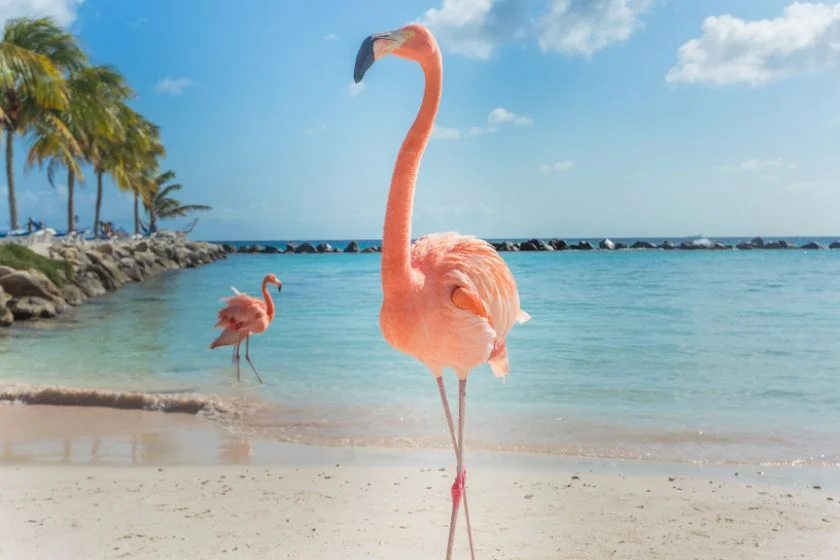
Scientific Name: Phoenicopterus
Flamingos are sociable birds known to reside in colonies or other social groups. These birds with long legs and curved bills favor shallow water areas like tidal flats, lagoons, lakes, marshes, and islands.
Several Great Flamingos leave southern Asia for warmer climes throughout the year’s colder months, seeking shelter in Iran or India.
The major nesting grounds for greater and lesser flamingos, which visit India every winter, are on the entire Indian subcontinent.
One of the original seven islands of Bombay, Sewri Mudflats annually welcomes thousands of greater and lesser flamingos.
Grey-headed Fish Eagle
Scientific Name: Ichthyophaga ichthyaetus
The grey-headed fish eagle is a South East Asian fish-eating bird of prey. It is a huge, stocky bird inhabiting various parts of the Indian subcontinent, Southeast Asia, Indonesia, and the Philippines.
The Grey-headed Fish Eagle regularly visits lowland woods close to rivers, big ponds, streams, and marshes. One can find this eagle around estuaries and along seacoasts.
Chinese Grouse
Scientific Name: Tetrastes sewerzowi
The Chinese Grouse (Bonasa sewerzowi), a bird unique to China, lives in the highlands, mostly covered in conifers.
It is the smallest grouse species in the world and inhabits the Grouse’s southernmost area.
In harsh winter conditions, they gather in small groups to forage on buckthorn berries in the open shrublands close to the timberline.
Old World Quails
Scientific Name: Phasianidae
The new world quails are a group of thirty-two species of small birds. Grasslands, farmlands, woodlands, and other open areas with a bush covering house these Galliformes, famed for their short wings and plump bodies.
The Japanese quail (Coturnix japonica), one of the old-world quail species, is an endemic species in Japan.
The king quail (Synoicus chinensis) in India and Sri Lanka and the Snow Mountain quail (Synoicus monorthonyx) in Indonesia are other old-world quail species that occupy Asia.
Southern Cassowary
Scientific Name: Casuarius
There are three species of Cassowaries; one of them, the southern cassowaries, can be found in Indonesia.
They feature long, dense black feathers, deep blue heads and necks, two vivid red wattles (flaps of skin), and a casque.
One can find these birds foraging along beaches and in tropical rainforests, paperbark swamps, mangrove forests, and woods.
Fishes In Asia
The Mekong, Indus, Euphrates, and other Asian waters are home to various freshwater fishes.
The Pacific, Arctic, and Indian oceans, the Caspian Sea, and other salinated waters provide the requirements for several marine species. Let’s consider some fish species in Asia.
Penang Betta
Scientific Name: Betta pugnax
The Penang betta course through fast-moving, sandy-bottomed streams in the forest, inhibiting Singapore’s waters, including natural preserves and the Nee Soon Swamp Forest.
The species also lives in rushing streams in Johor, Malaysia, some of which have substantial amounts of submerged vegetation. The Malay Peninsula and Sumatra are other places in Asia to find Penang betta.
Giant gourami
Scientific Name: Osphronemus goramy
The enormous gourami fish inhabits swamps, lakes, marshes, slow-moving rivers and streams, and marshes in Southeast Asia. Gouramis thrive in aquariums filled with plants since they naturally dwell in densely vegetated water.
In the wild, giant gouramis inhabit waters in Thailand, Vietnam, Borneo, India, and Singapore. Gourami bodies are flat In flooded woodlands during the rainy season.
The Giant Gourami migrates from the Mekong River’s mainstream into flooded regions during the rainy season, returning when the season is over.
Blackback Butterflyfish
Scientific Name: Chaetodon melannotus
The butterflyfish are renowned for the lovely patterns and hues they display. This species lives in the coral abundance of lagoons, seaward reefs, and reef flats across the southern parts of Japan.
Black Back Butterflyfish are fairly calm, nocturnal fish. During the breeding season, they travel, with juveniles frequently moving inshore in pairs or small groups.
Arabian Carpetshark
Scientific Name: Chiloscyllium arabicum
One can easily identify the Arabian carpet shark due to its mouth considerably in front of the eyes, large spiracles below, and long and rounded snout.
The Arabian carpetshark enjoys coastal waters with mangrove estuaries, coral reefs, lagoons, rocky shorelines, and muddy bottoms.
It resides in the Persian Gulf, the northwest Indian Ocean, Pakistan, and India at depths between two and one hundred meters.
Numbray
Scientific Name: Narke dipterygia
The numbray is an abundant species in the Southeast Asian nations and the Arabian Sea, with the rest of the species discoveries in India coming from the east and west coastlines.
These fishes occupy sand and mud bottoms in shallow bays and estuaries, bringing them close to humans.
However, trying to touch one of these species will put one in for a shock as they can release powerful electric currents from their bodies.
Rainbow sardine
Scientific Name: Dussumieria acuta
The rainbow sardine is a colorful fish with an iridescent blue and shining brass or gold mix. The Indo-Pacific region is home to the rainbow sardine, including the Persian Gulf, Bangladesh, Pakistan, India, Sri Lanka, Malaysia, Indonesia, and the Philippines.
Rainbow sardines are social fish that prey on crustaceans. As saltwater fishes, their main habitats are estuaries and shallow coastal seas.
Hoeven’s snake eel
Scientific Name: Pisodonophis hoeveni
Pisodonophis hoeveni, often known as Hoeven’s snake eel, is an eel from the Ophichthidae family.
The maxillary teeth usually characterize this genus, with a regular or asymmetrical row arrangement and conical or blunt and granular jaw teeth.
The Hoeven’s snake eel is a marine, tropical species identified by three specimens in the Indo-Western Pacific, encompassing Sulawesi, Indonesia, the Persian Gulf, and the Gulf of Oman, where it occupies lagoons and shallow water.
Extinct Asian Species
While Asia’s extant wildlife is satisfying, we still regret the extinction of some species, including the Flores cave rat (Spelaeomys florensis) and the Javan, Bali, and Caspian tigers.
The Japanese wolf (Canis lupus hodophilax), Japanese otter (Lutra nippon), Schomburgk’s deer (Rucervus schomburgki) and Japanese sea lion (Zalophus japonica) are other extinct species on the continent.
Places to Watch Wildlife in Asia
Asia not only houses these animals in the wild but in captivity, where they live in their natural habitats.
Below are some incredible destinations where you are sure to enjoy the extraordinary sights of untamed nature and wildlife.
- Ocean Park, Hong Kong
- Bandipur National Park, India
- Gir National Park, India
- Kanha Tiger Reserve, India
- Kaziranga National Park, India
- Tanjung Puting National Park, Indonesia
- Ujung Kulon National Park, Indonesia
- Tat Kuang Si rescue center, Laos
- Yala National Park, Sri Lanka
- Kaeng Krachan National Park, Thailand
Frequently Asked Questions
What kind of wildlife does Asia have?
North America houses many of the world’s most popular wildlife, including tigers, elephants, lions, bears, and pandas. Snakes, birds, and fishes also exist in abundance.
What habitats in Asia support wildlife?
In Asia, forests, wetlands, deserts, scrublands, and woodlands have the perfect climate and terrains to support specific wildlife.
What Asian country has the most wildlife?
Thailand houses about 10% of all species of the world’s living organisms, including 300 species of mammals, 980 species of birds, 2,800 species of fishes, and 490 species of reptiles and amphibians.
Wrap Up
Asia, the world’s largest continent by area, is blessed with a rich and diverse range of untamed nature, from scenic landscapes to exotic wildlife exclusive to the continent.
As the creatures continue to thrive in their various settings, we should take advantage of all avenues to support conservation efforts to ensure the continuity of these species.
Latest Asian Wildlife Articles
References & Notes
- Elephas maximus (Asian Elephant), via IUCN.
- V. Menon, S. KR. Tiwari, (2019). Population status of Asian elephants Elephas maximus and key threats. via ZSL.
- Buckingham, K., David, J., & Jepson, P. (2013). ENVIRONMENTAL REVIEWS AND CASE STUDIES: Diplomats and Refugees: Panda Diplomacy, Soft “Cuddly” Power, and the New Trajectory in Panda Conservation. Environmental Practice, 15(3), 262-270.
- Masanao H., Hidetoshi O., et. al. (1999). Phylogenetic Relationships of the Flying Lizards, Genus Draco (Reptilia, Agamidae). Zoological Science, 16(3):535-549.
- Ian Sample. (2009). Komodo dragons use venom to kill their prey, scientists discover. via The Guardian.
- Fariz F. (2014). 5 Cases of ferocity of wild Komodo dragons attacking humans. via Merdeka.
- Crocodilian Attacks, via IUCNCSG.
- The Wild Camel Protection Foundation (WCPF).
- Rarest ape species rediscovered in Vietnam. via Gibbon Research Lab.
- Rungsima Tanthalakha. Thailand’s Biodiversity: Thailand’s Competitive Advantage. NSTDA.

